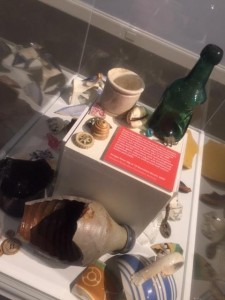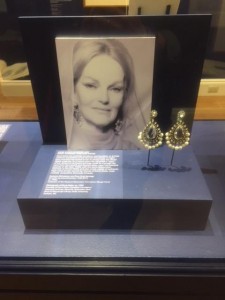 What happens when you put jewelry and Newport history in parallel exhibitions? Amazing things. The Newport Restoration Foundation marks 50 years, and what a great cause for celebration. Two exhibits are currently on display at Rough Point, the oceanfront estate of Doris Duke, and along with David Webb Jewelry, the showings are well worth the visit.
What happens when you put jewelry and Newport history in parallel exhibitions? Amazing things. The Newport Restoration Foundation marks 50 years, and what a great cause for celebration. Two exhibits are currently on display at Rough Point, the oceanfront estate of Doris Duke, and along with David Webb Jewelry, the showings are well worth the visit.
Doris Duke, an heiress to the late James Buchanan Duke, an American tobacco and electric power industrialist, spent many summers in Newport throughout her lifetime. Her introduction to David Webb Jewelry took place in the 1960s when she began frequenting his New York boutique. She understood and related to his designs. Changes in the American culture for women were emerging, and modern, innovative designs were paired with semi-precious stones. Doris’ jewelry emulated her lifestyle.
David Webb (1925 -1975) was a self-taught jeweler born in North Carolina. He founded David Webb, the company, in New York city’s jewelry district in 1948. Known for his animal motif designs and brooches, he catered to celebrity clientele, including Elizabeth Taylor and Jackie Onassis. Helen Mirren and Beyoncé have also worn his pieces. His company continues to operate at boutiques in New York and Beverly Hills.
 Doris was an insatiable collector, and her most impressive collection was her jewelry. Her introduction to Asia with her then husband, James Cromwell, at age 22, changed her interests forever. Her assortment of pieces was acquired from travels to the Far East, India and Europe, and includes jewels she inherited from her family. Doris often hired David to create specialty pieces with stones from her own collection. His process started with a pencil sketch and tracing paper on an 8 x 5-inch notebook. He kept a ledger book for client commissions with detailed information and drawings. There are several drawings in this exhibition marked with changes and iterations for Ms. Duke. Final designs were hand-painted on black cardstock for presentation.
Doris was an insatiable collector, and her most impressive collection was her jewelry. Her introduction to Asia with her then husband, James Cromwell, at age 22, changed her interests forever. Her assortment of pieces was acquired from travels to the Far East, India and Europe, and includes jewels she inherited from her family. Doris often hired David to create specialty pieces with stones from her own collection. His process started with a pencil sketch and tracing paper on an 8 x 5-inch notebook. He kept a ledger book for client commissions with detailed information and drawings. There are several drawings in this exhibition marked with changes and iterations for Ms. Duke. Final designs were hand-painted on black cardstock for presentation.
Much like the jewelry sketches, the gallery is adorned with restoration freehand drawings of houses owned by the Newport Restoration Foundation. One particular architect, Richard Long, worked on the Simon Pease House, one of the earliest houses owned by the NRF. His drawings served as tools for the foundation to preserve the architecture to original form. Both forms of hand-drawn art, from jewelry to architecture, serve as rarely shown works that created beautiful works in history.
The second exhibit, Newport Restoration Foundation at 50, is a compilation of artifacts, furniture, photos and history. Doris was an avid art collector and philanthropist; she began the Newport Restoration Foundation in 1968. Not only did she fund a majority of the project, she got into the details. Doris hand-picked architects, project managers and paint colors, and was instrumental in overseeing many on-site visits. The restoration exhibit is dotted with artifacts found from colonialists, including glass, pottery and toy fragments. There are samples of architectural features, including a variety of moldings, finials and posts. The acorn and oak leaf patterns were a common theme and symbolized strength and long life. These characteristics played a huge part for carpenters replicating the restoration of preserving buildings to their original design. Photographs of the historic Newport waterfront line the walls with a timeline motif that sets the tone for how Newport has been preserved and restored for future generations. The photo of the construction of the Claiborne Pell Newport bridge (commonly known as the Newport Bridge), is truly amazing. It opened on June 28, 1969, connecting Conanicut and Aquidneck islands. The 50 years shows us great progress in the Foundation’s work and inspiration. There is an excellent interactive piece that poses the question to the viewer: “What will Newport look like in 50 years?” You can create your own answer on a sticky note and stick it on the wall.
The exhibitions are currently on view in the Rough Point galleries through Nov 11; Newport Restoration Foundation: newportrestoration.org
More Posts by The Author:
Moby at Gallery Z’s ArtMobile
Skye Gallery
Raphael Diaz’s Silenced Voices
Peruko Ccopacatty’s Art Graces Kennedy Plaza
Visible Cloth, Invisible Bodies: Rhode Island Textiles and Southern Slavery in the 19th Century




